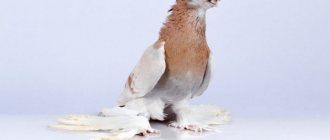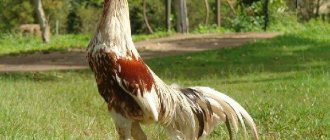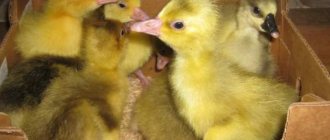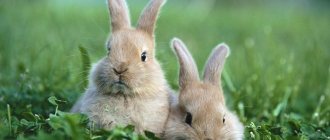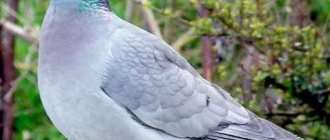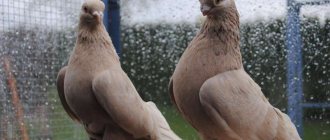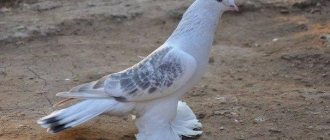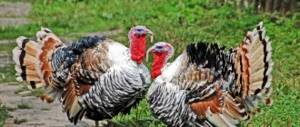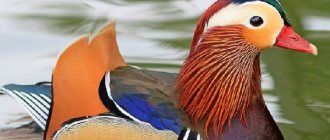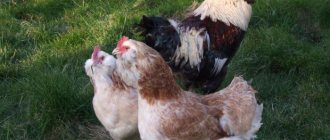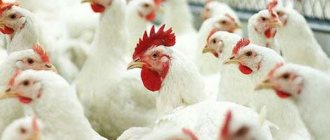Appearance and characteristics
The main feature of tumblers is the ability to fly high and for a long time, and tumble during flight over the head, wing or tail. Due to their tendency to fly for long periods of time, they have strength and endurance.
Expert opinion
Zarechny Maxim Valerievich
Agronomist with 12 years of experience. Our best country expert.
Ask a Question
A purebred bird is capable of performing many flips. Poultry farmers who breed this species specifically support this skill in their offspring.
The breeds differ in size, flight style, and plumage color. Common features are a small head with a convex forehead, large eyes, and a short beak. The iris of the eyes is dark. Turmans have an elongated neck, medium-length legs, widely spaced. The tail is raised and consists of 12-14 tail feathers. The average weight of the bird is 0.8 kg, the color is uneven.
Female tumblers have almost no developed maternal instinct; the lack of parental qualities is explained by the fact that many generations of pigeons were bred in an incubator. Many poultry farmers continue this tradition, using home incubators for breeding. The chicks are fed artificially.
Video “Oryol Cresteds in a private nursery”
Russian Oryol tumblers are another ancient breed, bred in the 18th century in Oryol. The plumage color of the birds is exclusively white; there is a small crest on the back of the head. Oryol tumblers are short-billed; as a result of crossing with gulls, the beak has become almost invisible. The head is compact, with a steep convex forehead. The eyes are large, dark, the eyelids have a blue tint. The body is small and compact, with a long, elongated neck.
Read more: Cherry plum Sonyika description of the hybrid variety
The Tula hot tumbler was bred two centuries ago in Tula. He still remains very popular in his homeland. This breed has managed to survive to this day without significant changes. The color of the birds is dark red, the tips of the wings and tail have white stripes. A tail with a white ribbon blooms in the air like a fan.
Oryol and Tula Turmans are very good parents. They are unpretentious in content.
To maintain the flight characteristics of pigeons, they require regular training. If we compare the somersault abilities of the Tula and Oryol athletes, the former retained them better. The fact is that the selection of the Tula breeds in recent decades has been aimed at preserving the main characteristics, while the Orlov breeds have changed, more in the decorative direction.
Kursk Turmans are one of the most common breeds in Russia. Nikolaev cloud-cutters, borodunov, and ribbon pigeons took part in its creation. Crossings occurred naturally, without much participation from breeders. The birds are large in size, have a wide chest with developed muscles, and powerful wings. The tail is wide, has from 12 to 18 tail feathers. The body color is black, the wings are white. The Kursk Pigeon has one of the best flight characteristics among all tumblers.
An interesting video from a pigeon nursery in which you will see Oryol white pigeons.
Rules of maintenance and care
Pigeons are social birds; they like to live not alone, but with their own kind. You can keep tumblers in a dovecote or in an aviary. The beginning of breeding should begin with the construction and arrangement of a poultry house and a walking area.
See also
Description and characteristics of Uzbek breed pigeons, breeding and careRead
Hygiene
The pigeons' housing should be spacious (up to 2 birds can be kept per 0.5-1 sq.m. area), bright, and warm. Make the aviary from a mesh and cover it on top so that the birds cannot get into the teeth of predators. Inside the dovecote you need to maintain cleanliness: change the bedding, clean the perches, feeders, drinking bowls, and nests. In a dirty room, the risk of developing infectious diseases increases. Every month you need to disinfect the premises without the presence of birds. Spread a bedding of straw, hay, peat, sawdust in a layer of 5 cm.
Temperature conditions are up to 25 ˚С in summer and up to 0 ˚С in winter. In winter, if the farm is located in a region with a cold climate, the poultry house needs to be insulated. Humidity is 65-70%; if it is damp in the dovecote, the pigeons will begin to suffer from infectious diseases. Lighting is natural in summer, for which the windows are facing south or southeast, in winter - for at least 12-14 hours. Keeping the animals on short days slows down the sexual development of young animals.
There should be no cracks in the poultry house that create drafts. A healthy atmosphere can be maintained around the clock if an automatic ventilation system is installed in the dovecote.
Pigeons keep their bodies clean by bathing in water. While in the dovecote, they will take advantage of the opportunity if a bowl of water is placed inside.
Feeding
The basis of the diet of tumblers is grain of various types, to which grated vegetables, root vegetables, fruits, and potato tubers are added. Feeding frequency – 3 times a day, volume – 40-50 g per day. During molting, breeding and in cold weather, birds need to be fed intensively and given protein feed - legumes (up to 15% of the total feed). From spring until cold weather, feed fresh grass.
Add a little salt, chalk, and yeast to the mixture. You cannot feed meat, fish, fresh bread, sweet, spicy, salty, smoked and fatty foods. The source of fat can be sunflower and flaxseeds, but not animal products.
Necessary equipment
Turman pigeons do not like to spend the night on the floor; they prefer to sit on perches. They are made from wooden blocks with a diameter of 3 cm. Perches are installed along the walls, starting at a distance of 0.3 m from the ceiling. For reproduction, nests are installed according to the number of parental pairs. They are placed at the far end of the dovecote, in a quiet, cozy place. Nests are located in cages or on shelves. After the breeding season, they are removed, disinfected and dried.
See also
Origin and description of rock pigeons, diet and status of a wild speciesRead
Feeders for pigeons are made oblong, with the upper part covered with rods so that the birds do not scatter the food. The material used is metal or plastic, which is easy to clean and wash. Drinkers are also made from light, strong, durable and easy-to-use material. It is desirable that they be automatic, then you will not have to pour water 3 times a day.
Also on the farm you need to have a broom, dustpan, bucket, sieve, and rake for caring for birds. And also a first aid kit, which will contain everything necessary in case the pigeons get sick: medicines and medical instruments.
Key Features
As mentioned above, the main advantage of Thurman pigeons is the beauty of their flight. Particularly interesting is the fact that representatives of some breeds can rise to a truly enormous height for pigeons: up to 500-600 m, and sometimes even more. At the same time, breeders pay special attention to another point: the flight style of Thurman pigeons, focusing on its complexity and originality.
Representatives of various breeds of these birds began to be bred quite a long time ago: in the 17th century, through crossing based on racing and high-flying pigeons. It is worth recognizing that the efforts of the specialists turned out to be entirely justified, because they managed to obtain many breeds, the representatives of which are able to organize real flight shows. If we list the most significant features of tumbler pigeons, their list will look like this:
- rather modest appearance, which in some cases can be called nondescript;
- compact body dimensions;
- a small head, which may be decorated with a forelock (depending on the breed);
- medium or short beak length;
- high forehead and elongated neck;
- large eyes with a dark color;
- light, almost white eyelids;
- powerful pectoral muscles;
- long wing length;
- a wide tail with about 13 tail feathers.
Read also: Volga ribbon pigeons: characteristics, features
Regarding the body weight of the pigeons in question, it should be noted that it is relatively large: about 800 g. Another characteristic feature of the Thurmans is the wide arrangement of their small legs, which can be clearly seen in the photo of these feathered aerobatics masters.
The price of the pigeons presented in this material also deserves attention. In general, it cannot be called democratic, which is primarily explained by the prestige of the Thurmans, which has been consistently high for many decades in a row.
Subtleties of breeding
In the spring, pigeons begin their breeding season. To obtain purebred tumblers, healthy, young birds without defects in exterior are selected from the adult population. The weight of females should not exceed the norm, otherwise they will not lay eggs. To control, you need to mark the date of laying of each egg in order to calculate when the chicks will appear.
In the nest of tumbler pigeons there are 1, usually 2 eggs. Incubation time is 16-19 days (the warmer the room, the faster the pigeons will hatch). Both parents feed the chicks until they are one month old. Then they move on to laying the next pair of eggs and incubating them. During the warm season they can produce several broods in a row.
Frequent diseases of birds
Pigeons of the Thurman breed group fly actively and can fly far from the dovecote. Communicating with birds, they can bring home infections: avian influenza, psittacosis, trichomoniasis, listeriosis, tularemia, pseudotuberculosis, campylobacteriosis. Some diseases are dangerous not only for pigeons, but also for humans.
The best way to avoid infection among livestock is regular cleaning and vaccination. Pigeons are vaccinated 2 times a year, in the off-season. Vaccinations are given at intervals of 2-4 weeks. The validity period of vaccinations is 0.5-1 year. Vaccination should then be repeated to continue developing immunity.
Thurmans are known among fanciers for their unusual flight, for which they are valued as the original pigeon breed. Even a beginner in pigeon farming can decide to breed birds; tumblers are unpretentious to food and maintenance.
Odessa, Bryansk, Ukrainian vertuns
Odessa Tumblers are a very old breed that is on the verge of extinction. The fact is that Nikolaev pigeons are very popular in Ukraine. Tumbling is unacceptable for this breed; it is considered a defect. Fans were guided by the Nikolaev pigeons and began to eradicate the ability to do somersaults in the air from the Odessa pigeons.
Read more: Broiler guinea fowl description of cultivation
The body of the Odessa tumbler is medium in size, has the shape of a cone, the head is flattened, reminiscent of a snake. The birds have a proud posture, the wing is long, its tips are located below the edge of the tail. The legs are bare, dry, with white claws. The plumage comes in different colors and always has a beautiful pearlescent tint.
Bryansk Turmans are an old but little-known breed. Distributed in the Bryansk region, partly in the Moscow region. The birds are tall, with wide tails, and a small crest on the back of the head. The color can be white, black, black-red, pockmarked. Pigeons fly in circles to great heights, and during the flight they can perform 3-5 somersaults. Flight duration is 3-6 hours.
The exact origin of Ukrainian vertuns is unknown. Presumably these birds arose from Turkish and Persian pigeons brought by the Cossacks. The size of tumblers is average, the head is round, without a forelock, the beak is average, but closer to short. The neck smoothly turns into a powerful chest, the back is wide, the wings fall under the tail, but do not touch the ground.
